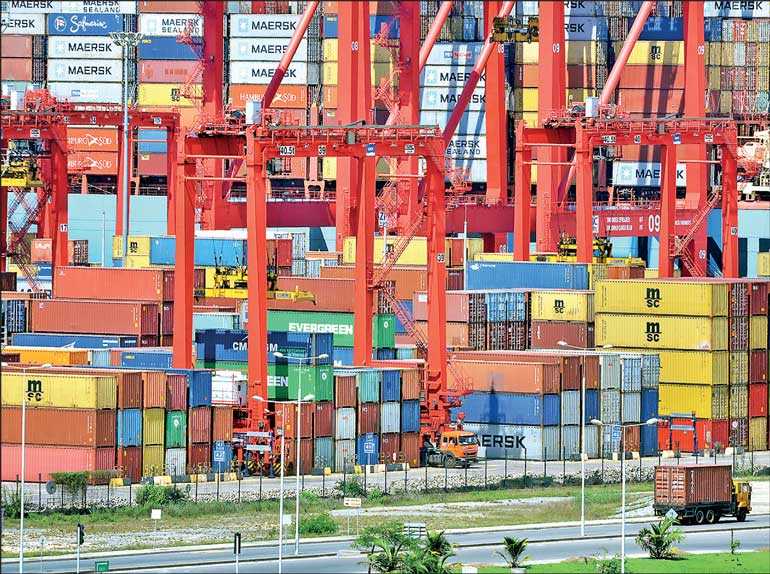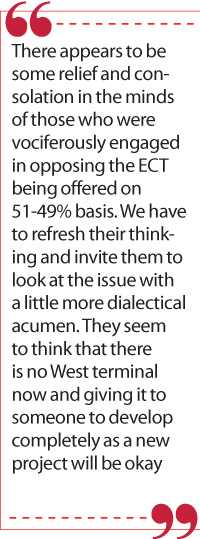Sunday Apr 20, 2025
Sunday Apr 20, 2025
Saturday, 6 February 2021 00:05 - - {{hitsCtrl.values.hits}}

It is not a question of whether it is the West part of the Port to be sacrificed instead of the East, but to have a clear picture as to who is at the bottom and why
 There was much controversy over the proposal to hand over 49% of the shares of the ETC (Colombo Port) to an Indian Company. A name was mentioned and the gravity of the issue was intensified due to questionable nature of the past records associated with this name.
There was much controversy over the proposal to hand over 49% of the shares of the ETC (Colombo Port) to an Indian Company. A name was mentioned and the gravity of the issue was intensified due to questionable nature of the past records associated with this name.
As far as the public of this country are concerned there is no clarity to date as to what this engagement was going to be. The opaqueness surrounding the issue with half-truths told and expressed political jargon for and against, served only to keep the facts that should be known to remain unknown.
Was it a development-based assistance? Can’t be, since it is a private company that is involved in the share transaction. Why then the matter is regarded as an operation causing much concern to Indian Government? The only conclusion would be that India is seriously concerned and at the same time a chosen individual should get it. And according to the trade union disclosures a Cabinet paper has been submitted to give it to that private entity. This presumption is further confirmed as announced by the Minister in charge of Port.
The proposed transaction devolved round the sharing of the shares of a company floated to develop the ECT on the basis of 51:49 ownership. According to the Government spokesmen it was neither a sale nor a lease. It is hard to believe that the shares were to be given free for some other consideration. Then it is a sale of shares and as long as the entity survives 49% ownership will continue with the rights of 49% ownership guaranteed by law unless otherwise there are other conditions binding on both shareholders agreed beforehand specifying any special arrangements.
It is here the concerns of the trade unions, social bodies, religious dignitaries become important and relevant regarding the track record of the involved party and to know, how blemished and a chequered past record the party has. Public concern too is focused on this particular aspect to that extent and when we dig into the matter the revealed information is significantly alarming. So now it is not a question of whether it is the West part of the Port to be sacrificed instead of the East, but to have a clear picture as to who is at the bottom and why? Therefore, we lay bare some of the factors discussed in various forums about a company called Adani while reserving our inability to affirm that the Adani disputed in the Sri Lanka ECT matter is the same or a different one.
This consideration is important because now there appears to be some relief and consolation in the minds of those who were vociferously engaged in opposing the ECT being offered on 51-49% basis. We have to refresh their thinking and invite them to look at the issue with a little more dialectical acumen. They seem to think that there is no West terminal now and giving it to someone to develop completely as a new project will be okay. But if the West, which is adjacent to the East terminal, is to be given to the same disputed party, the background we are going to discuss will become important. In a wider interest, public information about the integrity, past operations and publicly shared information available about adverse experiences, of any party to be entrusted with a strategic development project, becomes highly relevant.
 Mining giant Adani
Mining giant Adani
The following extract is a summary of a published report of the track record, of a mining giant called Adani based on research into hundreds of court documents by Environmental Justice Australia and Earthjustice and other publicly available evidence.
Adani is an Indian mining and energy company and these revelations came in the context of a contract they were seeking from the Australian government to build the world’s biggest new coal mine in central Queensland Australia. In a public poll 74% of the Australians opposed Adani’s engagement in the proposed project there, due to a sordid past track record available to them about this company. The report published new and previously documented evidence that shows Adani are, at their core, a dangerous, criminal organisation, not fit to be trusted with one of the most environmentally destructive projects in Australian history.
At the time this opposition were building up Adani had a documented history of corruption, bribery, and human rights abuses across the world. It was also facing further criminal investigations for alleged involvement in multi-billion dollar fraud in India.
 Threats and police intimidation in land grab
Threats and police intimidation in land grab
Media reports from India reveal Adani is using police intimidation, bribery and threats to dispossess people of their land in Jharkhand – where the company wants to build two power plants.
Villagers and government officials say the Jharkhand Government has deliberately undervalued local villagers’ land to allow Adani to acquire the land at a fraction of the land’s real value. One legislator raised the issue in state assembly, contending landowners are expected to receive about one tenth of the value of their land.
Community meetings on the sale of the land have been surrounded by a heavy-handed, intimidating police presence.
Further, this report stated that agreements and commitments it makes appear worthless. This is a company that doesn’t hesitate before breaking the law, contract conditions or moral boundaries in its reckless pursuit of profit.
Adani’s proven track record of environmental destruction, human rights abuses, corruption and illegal dealings should sound a stern warning for any government looking to do business with Adani.
If this is what is happening elsewhere, and the highly controversial nature of the involvements in business activities and projects undertaken by those concerned, our government should think carefully and examine the veracity of these allegations before entrusting any project to them in the country.
What is currently going on India as a vehement protest action by farmers is a good example. It appears that this company is wielding a lot of favouritism from the Indian Government. This seems to be overflowing into our affairs too. The ECT project has been recommended to them apparently without following any procurement procedures.
Port Development National Policy in India
In the context it is pertinent to examine the current engagements, development plans and ongoing projects in India on port development activities.
I chose to quote direct from, a report by India Brand Equity Foundation titled ‘Shipping Industry and Ports in India’ last updated 30 December 2020:
Government initiatives
Some of the major initiatives taken by the Government to promote the ports sector in India are as follows:
Achievements
Following are the achievements of the Indian Government in the past four years:
Road ahead
It is not difficult for anyone to understand the magnitude of the competitive arena we are exposed to in this game. Survival is extremely sensitive and subject to severe pressure. Unless we take into account all these factors we will not be able to strike a balance.
This is why I was compelled to post a comment on a Facebook write-up praising substitution of WCT project in place of ECT as a solution to the controversy, stating, “My dear friend there are many other factors unseen!”
Discover Kapruka, the leading online shopping platform in Sri Lanka, where you can conveniently send Gifts and Flowers to your loved ones for any event including Valentine ’s Day. Explore a wide range of popular Shopping Categories on Kapruka, including Toys, Groceries, Electronics, Birthday Cakes, Fruits, Chocolates, Flower Bouquets, Clothing, Watches, Lingerie, Gift Sets and Jewellery. Also if you’re interested in selling with Kapruka, Partner Central by Kapruka is the best solution to start with. Moreover, through Kapruka Global Shop, you can also enjoy the convenience of purchasing products from renowned platforms like Amazon and eBay and have them delivered to Sri Lanka.
Discover Kapruka, the leading online shopping platform in Sri Lanka, where you can conveniently send Gifts and Flowers to your loved ones for any event including Valentine ’s Day. Explore a wide range of popular Shopping Categories on Kapruka, including Toys, Groceries, Electronics, Birthday Cakes, Fruits, Chocolates, Flower Bouquets, Clothing, Watches, Lingerie, Gift Sets and Jewellery. Also if you’re interested in selling with Kapruka, Partner Central by Kapruka is the best solution to start with. Moreover, through Kapruka Global Shop, you can also enjoy the convenience of purchasing products from renowned platforms like Amazon and eBay and have them delivered to Sri Lanka.